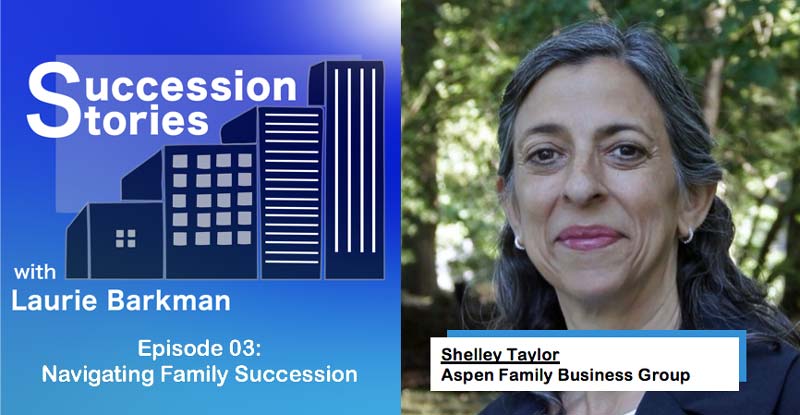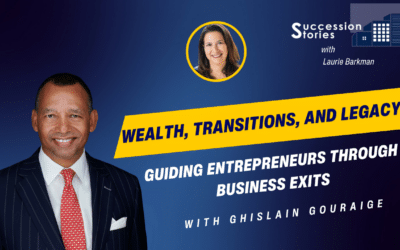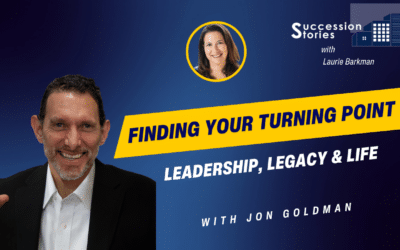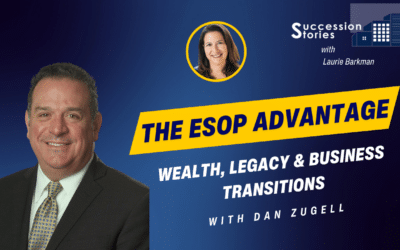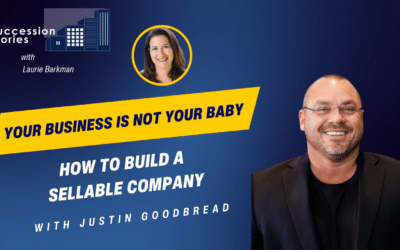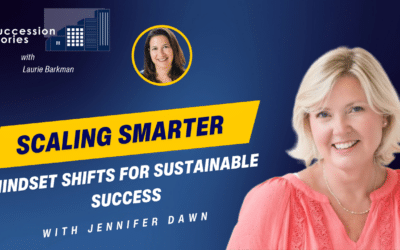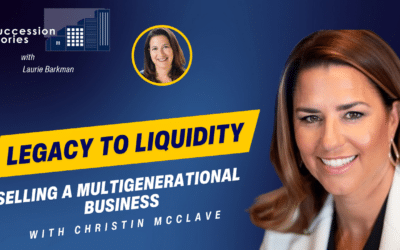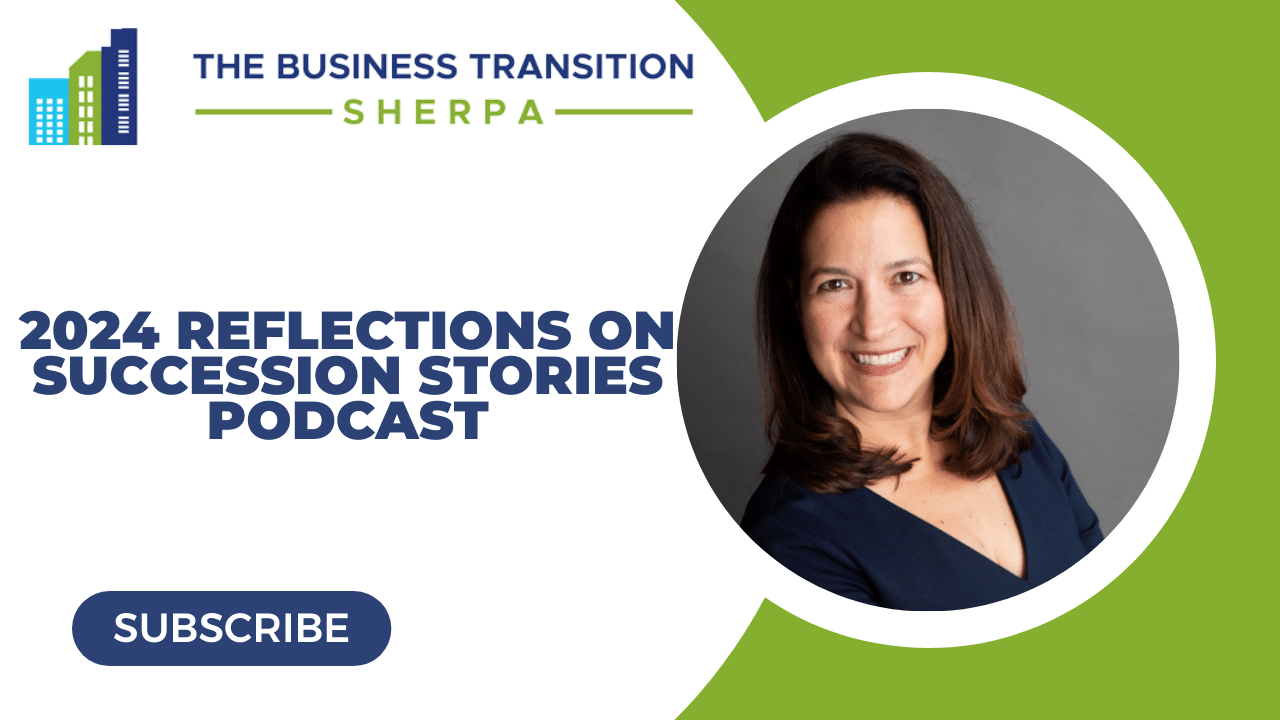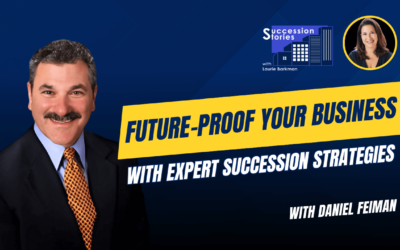This episode features Shelley Taylor, a family business advisor and expert on navigating family succession. Shelley has worked with multi-generational companies for more than 20 years, and she is the Family Council Chair for ABARTA, a 3rd and 4th generation company running one of the largest Coca-Cola distributors in the US. Shelley shared best practices for succession and ways to develop the next generation of leaders. For her family, next generation development is not only about employment, it’s about developing a sense of ownership and stewardship of the business and what it means to be an owner.
Show Links
Shelley Taylor LinkedIn
Full Transcript
Laurie Barkman (00:00):
Welcome to the Succession Stories Podcast, insights for next generation entrepreneurs. I’m Laurie Barkman. On this episode I speak with Shelley Taylor. Shelley has a deep understanding of multi-generational businesses. She is a family business advisor working on generational transitions and next generation development. She is an associate with the Aspen family business group and has worked with member companies at the University of Pittsburgh’s Institute for Entrepreneurial Excellence for almost 20 years. Shelly is also the Family Council Chair for ABARTA, a third and fourth generation family business that owns and operates the 10th largest Coca-Cola distribution company in the United States. Shelley spoke about the importance of legacy, types of succession, and strategic ways to work on the business and not just in the business. I enjoyed learning from an expert about family business succession and think that you will too.
Laurie Barkman (00:58):
Shelley, thanks so much for joining me on the Succession Stories podcast today.
Shelley Taylor (01:02):
Yes, hi Laurie. Thank you very much. Happy to be here with you today.
Laurie Barkman (01:07):
We have so much to talk about. You’re an expert on family businesses because you’ve consulted and advised hundreds of companies over the years. You’ve learned a lot along the way, and you’ve been able to apply this to the family enterprise that you’re closest to, a company called ABARTA. We’ll talk about both of those areas. First, let’s start with the field of family business practitioners and your experience as a family business advisor. Can you give an overview of the field and what your role entails?
Shelley Taylor (01:36):
The field of family business started in the 1980s both as a research discipline and an advisory field. Now it has developed over the years. There’s a research journal, lots of practitioners coming from a variety of fields. Some come from organizational behavior, some have a business background, people from law, wealth advising, so lots of areas to pull from. Working with families in the family business advising field, what we do is create a safe place for families to have conversations, a container, if you will.
It’s a place where families can get together to talk about things that they might not otherwise have a place to talk about. We’ll facilitate conversations to help them uncover shared values, which then leads to development of a shared vision and this helps them have a guidepost something to help them in the future and now know if they’re headed in the right direction. They’re following their goals, they’re behaving in the way that they decide that they want to behave together as a family. And through that, once they have that template in place for sort of behavior and how to follow their goals and dreams, they can work on areas like succession and governance, and role clarity, and development of the next generation as appropriate.
Laurie Barkman (03:04):
I like how you mentioned a safe place and ways that families can have difficult conversations in a container. I imagine there are conversations that are harder to have. What do you find are some of the biggest challenges facing multi-generational businesses today?
Shelley Taylor (03:21):
Yes. I think that from my perspective, communication is really one of the biggest challenges. And face it, even in the best of times and whatever environment one is in– a family business, a family, a regular business — good communication is really important. So as I said, one of our goals is to create a place for good communication on top of the normal communication challenges. Family businesses have an additional component, which is emotion. Families are run by emotion. Businesses are run with rational, usually, rational focus. So when you overlay the emotion on top of the business component, things can get kind of tricky. That’s why we like to work on something that we call role clarity, which is helping people understand, “am I behaving right now like a mom or a brother?” Or “is this really a role as a manager or as an owner?” And so we try and help families with those distinctions.
Shelley Taylor (04:20):
Overlaid on top of that would be a governance structure to help them understand and help them have decision making mechanisms in place. So for instance, in a business, governance structure is usually pretty clear. You’ll have a management team, you’ll have an organizational structure. In a family, traditionally it’s mom and dad make all the decisions. But when you have adult children involved, it’s a little bit different and a little trickier. So as adults, children as adults with their parents, with other family members may be cousins. We need to sort of work on what’s the decision making structure going to be, how are we moving forward as a family in business. And then also the third area of governance is Boards of Directors. A board represents the ownership. So that’s a governing structure for the owners of a business, which might be all family members, might be a subset of family members. The other thing that we get to do in the family meeting environment is talk about the history of the business and the history of the family. And it’s a place to pass down legacy culture, some of those intangibles that you know, some families talk about those things over Thanksgiving, but it’s also a place to come together where everyone can participate in the conversation and everyone is hearing the same message at the same time.
Laurie Barkman (05:37):
So there’s a lot of important things you just talked about there between governance and communications, decision making, and role clarity. And you talked about legacy. When there are challenges in a traditional company and things just don’t work out with people you can part ways. But in a family business you can’t necessarily do that. There’s still part of Thanksgiving dinner. Have you encountered where there has been a family business breakup?
Shelley Taylor (05:58):
Yes, and unfortunately and that’s really very sad and sometimes the work that we do on families is to help them. If a family is proactive and working on doing this kind of work before there are challenges, obviously the chance of a better outcome is much greater. So that’s what we hope for. But in the case of others, sometimes it takes years to heal old wounds. Sometimes people aren’t willing to come back to the conversation and it is very sad when there’s a family schism due to what’s happened in the business. But yes, it does happen.
Laurie Barkman (06:34):
In family businesses, succession is so important. That concept of legacy is about continuity of the family with ownership and management. That’s not an easy thing to do inside of a business, but I’m really curious your experience with that. It’s certainly probably one of the challenges that you work with your clients on an ongoing basis. It’s certainly not a ‘one and done’ as generations move to the next. And historically the percent of companies that transition pass the third generation is a low number. I think it’s under 10% if that’s right. So what has been your experience with clients with respect to succession? You know, again, I’m guessing it’s not always straight forward.
Shelley Taylor (07:14):
Correct. One of the things that when we work with a family and they’re thinking about succession or developing the next generation, we encourage families to provide exposure to the business at a young age for their children and other next generation family members. So that can be summer jobs, can be internships, weekend work even when they’re in high school. But you want to be careful to not be passing down expectations like you’re hoping that the child might someday come into the business. So really sort of a no strings attached exposure. And then once someone is out in the work field, we like to encourage families to really seriously think about outside work first so that a young person can really establish him or herself, have a track record of successes in a job outside of the microscope of the family, not coming in with the family last name, and really have objective assessments of one’s work.
Shelley Taylor (08:18):
And then sometimes when someone has worked elsewhere they can bring in great ideas back to the business. But in terms of the work that we do with the families on succession, once maybe there’s someone in the business who might be thinking about moving up the ladder we like to provide, then opportunities for that person for exposure maybe outside of the business, even if they’re working in the business. So getting mentors from outside the business that might help with some skills or operational things, or even communication, or leadership, or also just sort of understanding the whole field of family business dynamics, and how one might really fit into the puzzle.
The other thing about succession and family businesses, it’s not only a leadership or an ownership succession. One of my colleagues wrote a piece called the Seven Dimensions of Succession and I think that’s really important, and I work with my families on all seven of these. In addition to leadership, and ownership, and management. Most people can understand what those are. We talk about succession of knowledge, succession of authority, succession of relationships, and succession of values. And so all of those take time, take conversations, introductions to people and it’s really a planned way to make sure that all aspects of the transition are covered. I also want to say that succession is not a once and done. It’s not a moment in time. It’s really a process and it takes planning and time.
Laurie Barkman (09:50):
Absolutely. Succession is not a one and done. It’s an ongoing process and it’s very interesting to hear about the different dimensions of succession and knowledge, relationships, and values. What happens when there’s someone who doesn’t want to work for their family business? Why do people want to or not want to be involved?
Shelley Taylor (10:08):
Yeah, and that’s a good question too. And part of the reason for bringing the whole family together to have conversations. As I mentioned, the shared values and the shared vision. One of the questions is how are people viewing the business? Is the business a piggy bank or is it something that’s an opportunity? Is it an entitlement, is it a right or is it a responsibility? So how do we view that?
We briefly talked about legacy and as a family business gets older and the generations, so third, fourth, fifth generations, the business is often viewed as an heirloom, as the grandma’s silver. So people, they view it as sacred and so it’s not just, okay, I get to work there if I want, but it’s a special opportunity. And the other conversations surround family, what we were just speaking about before, a family is the most important part.
Shelley Taylor (11:04):
We have a family business. It’s a great opportunity, but first and foremost we are family members and we want to make sure we take care of those relationships. So to your question about the reasons that people sometimes want to go work in the family, sometimes there’s a real desire. It’s desire based, it’s passion. That’s what they want to do. Sometimes they feel a responsibility. It’s an obligation. They need to come in to take care of their parents or their grandparents or their uncles, but as long as they’re talented and they have the skills, that’s okay. The things that we like to stay away from are someone who feels he or she needs to work for the family business because if he doesn’t, he’s going to be cut off from the family, either cut off from money or cut off from relationships. The other is a person who feels that’s the only option for him or her. I can’t find a job anywhere else. I don’t have any skills. I might as well go work for the company they’re going to pay me. So those two, you want to stay away from.
Laurie Barkman (12:05):
I’d like to learn more about ABARTA. This is a family company you’re a part of. The company is in it’s third generation. As you phrased it, it’s now focusing on the fourth. There’s a strong strategic family process in place. Tell me about that.
Shelley Taylor (12:20):
ABARTA got its start in the 1930s. My husband’s grandfather acquired a newspaper in Bethlehem, Pennsylvania. That was the initial business. We are no longer in the newspaper business. We were until 2014, and as with all businesses who are going to survive for 80 or 90 years, you need to reinvent yourself along the way. You need to change with your time. So that’s one thing that happened in our case. ABARTA itself was formed as a corporation in the 60s when my husband’s grandfather had three daughters. The three daughters and their husbands formed the company ABARTA, which is an acronym based on the last names of those six involved. So Adams is the three A’s, and then the B, R and T or were the last names of the husbands, who with their wives, formed the corporation. And that was formed to invest in some Coca Cola bottling operations.
Shelley Taylor (13:16):
We are still in the Coca Cola business. That’s our primary business now and we’re the 10th largest distributor bottler and distributor in the United States, private, independent. We have a family meetings process that we initially started back in 1990 when we were transitioning from the second to the third generation, prior to the transition. The reason we did that was we had learned, one of the family members learned, that the success rate is much better for families who engage in family strategic planning. So we hired a consultant and we got together twice a year as family owners and spouses. I was included from the beginning in that group. There were three members of the second generation participating at that time and eight to ten members of the third generation participating at that time. We had lots of children, lots of babies were born in the eighties and nineties, and so we had babysitters who would come and help us with that. But we worked on those topics that I mentioned earlier.
Shelley Taylor (14:16):
We worked on governance structures. ABARTA had already had an independent board of directors. ABARTA has been pretty forward thinking and a lot of their processes and structures along the way. They’re a pretty sophisticated company. We still like to learn from others. We already had a board of directors, but we learned about responsibilities of ownership. We learned about role clarity, we learned about coming into the business, and those kinds of things. And so one of the things we worked on in those early years was the policy for employment in the business, which we called the participation policy. We spent a long time working on that, putting in a requirement for outside experience for the next generation people when they were to come of age for them to be interested in working in the business. So anyway, everyone got busy in their lives. We had a process going for quite a while, over 10 years.
Shelley Taylor (15:06):
But then we had adolescents, teenagers, and we took a break and then six years ago we started up again. And that was really at the encouragement and urging of the fourth generation. They wanted to get back together and have these big conversations. There were siblings obviously, but then there were a lot of cousins, first cousins and second cousins. As a large group we hadn’t been spending a lot of time together. We realized as a third generation that we had really dropped the ball. There were critical years during which we had missed the opportunity for a really good education for the next generation. And so this for our family is not only about employment, it’s about ownership and stewardship of the business and what it means to be an owner. We always want to have family members on the board. In fact, our bylaws state or our understanding, I don’t think it’s in the bylaws, although it may be– that our chairman will always be a family member. Since the members of the third generation who are still leading the business are in their late fifties and early sixties, we know that it’s time to start really seriously planning for a succession of those leadership roles, both in the business and the board level, the ownership structure.
Laurie Barkman (16:12):
Is a Family Council separate from the board of directors?
Shelley Taylor (16:15):
That’s correct. That is the third part of the governance structure. We like to use a Venn diagram, which is a three circle model. The family is one circle. The business is another circle, and the owners are a third circle. And there’s overlap. There are some people who were in all three circles, so they overlap in that center, but there are some people who are only in a one. But in our case, all owners are family members but not all family members are owners. For instance, I’m a spouse and I’m considered family and I’m not an owner.
Laurie Barkman (16:51):
That’s why the role clarity is so important. The Venn diagram you mentioned is a really good visual, so thanks for sharing that. I’m curious about bringing the next generation in. Do you have any special ways that you try to do that? Is it just conversation or are there other things that you do too?
Shelley Taylor (17:05):
Well we do. We have something we call our “coming of age ceremony” that we do when the teenagers are 14, give or take, and that sort of signifies we are welcoming them into the process. We have a special formal dinner. We have speeches, we pass along a coin, which represents a couple things. One is the year that the business was founded, but the other is we have a complicated mechanism for tie-breaking in a family voting trust, which holds the voting shares of the business. If no agreement can be reached after many, many steps through the process, then the coin flip is the last decision maker. And the idea is that no one wants to leave anything to a flip. So we will do our best to work out any differences of opinion before it gets to a coin flip.
Laurie Barkman (17:56):
That must be a really special event when someone gets a coin.
Shelley Taylor (17:58):
It is. It’s a nice event. And the other thing that we’ve been working a lot on recently is how to welcome in spouses. Because we have a large family, we also realize that since there are a lot of us and there’s a strong culture and there’s a history that just letting someone walk in the door or pushing someone in the door is not the way to do it. So we have a very open door policy. We want people to feel comfortable in our meetings, but first with the spouses, we want to bring them into social events first. We wear name tags so people can become familiar with who we are and then if the significant other, either the family member or the person coming in wants to go further, we provide whatever information and support we can and the open door also applies to if people do not enjoy sitting around for six hours in a room discussing all these things.
Shelley Taylor (18:52):
That’s okay too. We feel that the family members, spouses, et cetera, everybody is really important to the whole, so we want to include them if they want to be there. But there is no judgment for family members or spouses if someone does not want to participate.
Laurie Barkman (18:04):
That sounds like a really inclusive process. Sometimes in family businesses, or any business, things don’t work out as intended. Is there anything from ABARTA’s experience that you can share some lessons learned along the way?
Shelley Taylor (18:19):
Well, I did mention our participation policy. That was something we put in place when we as a third generation were in our thirties. And we were trying to see into the future. We thought, wow, we have all these kids that were 17 at the time, they’re 19 now. There’s not going to be room for everyone working in the business. We know that outside experience is important.
Shelley Taylor (19:40):
So we’ll put that in the policy and we’ll make it a long time. We’ll make it five to eight years. During that time, maybe they get a graduate degree, that would count towards those years. But we want them to really establish themselves outside of the family business. And then we also thought it really messes with the hierarchy when you have family members at all different levels within a family business. So let’s just say leadership and leadership level — leadership potential or leadership level is where we want the family members to come in. Well as I mentioned, we took a break in our family meetings process and when we got back together, and we had all these next generation family members in their twenties and nobody working in the business, and nobody really interested in working in the business, we started to have some conversations around the policy and realized that it was pretty off putting. We didn’t realize it when we put it together.
Shelley Taylor (20:28):
So we spent time working on that reworking. We lowered the outside work experience age. And this now is a committee with fourth generation family members because it’s their policy. It’s the one that they’re going to have to live with. And so they were very instrumental in reframing it and we had a lot of conversations about what level in the business was appropriate for family members to be working in. And we took a step back and thought if someone is really passionate and they want to be there for the right reasons, maybe it’s okay to be not in a leadership suite. What we do think is important, however, is to have a lot of education surrounding what it means to work in a family business. In fact, we put together a document, a white paper, if you will, about that just so that people really have an understanding of the impact their words can have simply because they’re a family member.
Laurie Barkman (21:18):
That’s a great way to get the fourth generation involved, Shelly. They have a hands on assignment that also impacts their future. What do you think are some of the factors influencing owner readiness or lack of readiness for business succession? Why wouldn’t owners start planning or have started planning already?
Shelley Taylor (21:36):
Well, so as an owner, as a leader, planning for someone to succeed them, emotions are a big part of it. Lots of times, if it’s a founder business, a founder entrepreneur, they’re used to being hands on all the time, so it’s hard for them to let go often of the control. But there are a lot of emotions involved. A leader is reluctant to choose among his or her children that doesn’t seem fair. Or they might sometimes see them still as children and not adults. That’s pretty tricky. Lots of times leaders – and this can be in family business or non-family business – but a leader who’s been really involved in running a business, that’s all he or she knows. And it’s really hard to think of life after the business. Now in a public company, you have a board of directors who’s going to make that decision. That’s one of the reasons that we advocate and encourage families to have boards of advisors or boards of directors as part of their governance structure. One of the primary roles of a board is in CEO succession, so they can both challenge a current leader in terms of thinking about his or her own timeframe, and also encourage a pipeline of leadership readiness in a company, in a family, and challenge a family and say, what are you doing to prepare next generation leaders? And if there’s not someone from the next generation, what’s your plan?
Laurie Barkman (23:01):
What are some resources that you recommend for family business owners looking to get started on succession or transition planning?
Shelley Taylor (23:09):
Well, there are a lot of resources out there. There are programs, university programs similar to the one we have at the University of Pittsburgh, but they’re all across the country. There are a lot of resources online with books and tools and articles and blogs. My group, The Aspen Family Business Group, has a lot of information on our website and there are several others who are similar in materials that they offer. I also think that getting to know other family businesses and learning from them is very valuable. That’s one advantage to those university-based programs. Not only do they hold education, but they have networking opportunities for family members, families in business. I think peer to peer groups are great forums. I think they’re great both for the leaders who are thinking about retiring or succession, and also great for next generation people to learn from each other. Things about advancing in their career and getting more skills, more knowledge and just hearing the stories about how other people did it.
Shelley Taylor (24:10):
The thing about family businesses, lots of times people feel like they’re the only ones going through it. The field has changed enough in the past 20 years, so there’s enough out there now. But in the early days, family businesses were sort of in their own little cocoon and thought that those challenges they were facing were really theirs alone.
Another thing that’s really great for developing next generation people is mentors. I mentioned that a little bit earlier. And that mentoring can happen in the business, in the family, outside the business. There are lots of ways to tap into great resources, smart people, people who’ve been there and have experiences. A colleague and I have been doing some research on mentoring and family business and we uncovered three mentoring needs within family business.
Shelley Taylor (24:59):
We call those operational needs and that’s pretty obvious. That’s sort of the skills and the tools to do your job, et cetera. And then there’s the legacy need for mentoring. And that would be how are you learning about the values of the business, and the culture of the business, and just so that you can, as a family leader and family business leader help perpetuate that. And then the third area is what we call, we need a catchier name for it, but we call it the human systems area. And that’s really understanding the whole dynamics, the stuff that we’ve been talking about today in family business, those three circles, how everything fits together. How the emotions are involved in decision making, even when it’d be better if we could take emotions out of the decision making, all those relationship pieces. So I think mentoring and those mentoring needs, we’re positing in our work that those needs can be met by one person, two people, three people, more than three people.
Shelley Taylor (25:57):
So it’s not really just one person covers one topic area. But to have a really good breadth of influences and experiences and inputs to help with the development of the next generation leaders.
Laurie Barkman (26:10):
Mentorship can be very powerful in the development of next generation leaders.
Shelley Taylor (26:15):
Yes, in succession, when we talk about how a family business, either a family business leader or a board of directors, how they’re going to choose who the next leader is. It’s really important not just to look at individuals and pick one, but to really figure out what the role requires and develop a matrix, if you will, of the skills, the characteristics, the experiences that are required for a particular role. And then if there are several candidates, if there’s a family member who checks all those boxes, or maybe even checks most of those boxes, we understand that the preference is going to go to that family member and that’s really appropriate. Then we can use those other developmental tools to fill in the areas that that person might be lacking a little bit. But if there’s no family member who’s fit for that role, who checks all the boxes or most of the boxes, it’s okay to go to a non-family leader either for a period of time or maybe that might be the path for the company.
Shelley Taylor (27:14):
Some people are look that it’s a scary prospect, but it’s not a bad one. And there are people who are looking at that interim CEO, that non-family role. There are people who are at a place in their careers, they understand it’s a family business. They’ve had maybe a successful career. So this is somebody who’s not maybe in their forties really, go go go, and I want this to be my forever job. But maybe someone who has a good 10 years left in their career, and that person can then serve as a mentor to the family members who maybe aren’t yet old enough, and have the potential, but need a little bit more time or just extra mentoring and help and support. So I just wanted to put that piece in.
Laurie Barkman (27:54):
That’s great advice. Thank you. I like to ask all my guests if they have a favorite saying. Do you have a favorite saying or mantra regarding entrepreneurship?
Shelley Taylor (28:03):
Absolutely. Well, I like to say, and this is not unique to me, but I think it’s important for people to spend time working on their business as well as in their business. That’s what we aim to do with a lot of this work.
Laurie Barkman (28:17):
That’s a great quote. Thanks so much, Shelley, for being with us today and for sharing your succession stories.
Shelley Taylor (28:24):
Thank you, Laurie. I enjoyed it very much
Laurie Barkman (28:26):
And just to note, there are publications and other helpful resources for family businesses on the Aspen family business group website at aspenfamilybusiness.com.
Thanks for listening to the Succession Stories Podcast. I hope you enjoy this episode and that you’ll consider sharing it with a friend. If you think it’s worth five stars, please go to iTunes and rate it so that others can find it as well.
I would love to hear from you. Tell me what insights inspired you today and if you have suggestions for content, please let me know. You can reach me @ Laurie Barkman, on LinkedIn, Twitter, and Instagram, or send an email to successionstoriespodcast@gmail.com.

